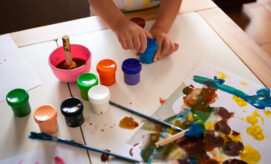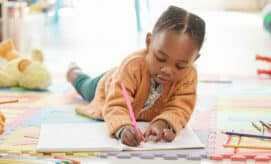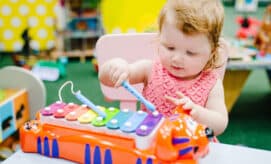This sensory paint project uses only two materials – tempera paint and a large piece of butcher paper. If you don’t have butcher paper available, this activity can also be set up using recycled cardboard. The fun twist on this painting activity is that little ones get to paint with their feet! To get started, invite the children to take off their shoes and dip their feet in different colors of paint. Encourage them to walk over the paper, leaving behind a colorful design.
Making Your Project a Success: Things to Remember
Collaborative art projects are a unique opportunity for children to create and interact with their peers. In order to make the project a success and to help children get the most out of the experience, it’s helpful to keep in mind the following tips:
Large-scale projects take time.
Because of their size, these kinds of projects can take a while, and might not be completed in one sitting. It can be fun to offer these activities to children multiple times, so they can try new approaches or continue to add to existing artwork. You might also leave an artwork that is in progress hanging on a wall in your classroom or on a fence outside, so that children can revisit it when they feel inspired.
You can also extend a collaborative project by stretching it out over a few days so you can introduce different art materials that children can use to add layers to their project. For example, offer just paint the first day, then add colored pencils the next day, and stamps the next. This allows children to spend more time connecting with peers as they gradually create a beautifully textured final product.
Everyone is invited to be a part of the process – even grown-ups!
Allowing children to take the lead is a beautiful thing, but creating and working alongside children can also be a great way for you to connect with them! Meri Cherry, an art teacher, author of The Process Art Handbook, and founder of Meri Cherry Art Studio, shares how she gets involved in collaborative projects while working with young children: “I give out an art material, demonstrate how I might use it and wait while the kids work. I often work with the kids…If I’m engaged, the kids tend to be more engaged.”
There’s no “right way” to create.
Collaborative art projects are process art experiences, meaning that they are intended for children to create freely, with no intended outcome. The art is focused on the experience and exploration – there is no right or wrong way to create! This means that children are encouraged to get creative and follow their own artistic inspiration as they work alongside their peers and create something special that represents the uniqueness of each child and the group as a whole.








